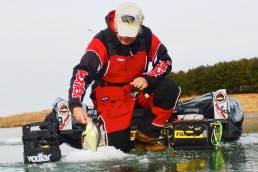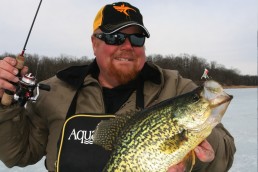Ice Trophy Fish
SHARE THIS POST
Now it’s your turn
Have you ever wondered why that one fishing buddy always seems to have the lucky hole? Year after year he or she always gets that Facebook hero photo of an elite-caliber fish. You, on the other hand, never seem to ice trophy fish. You’re always the one who just can’t quite lay your hands on the beast! Well, what if I told you that you can hook more big fish. Turn those big bites into pure glory on a consistent basis? What if it wasn’t luck? What if you could actually stack the deck in your favor to actually ice trophy fish year in and year out?
Set goals to set yourself up for success
When anglers actually set a goal, they are far more likely to reach it. If the goal is a pail full of eater-class fish for supper, certain locations, tackle and techniques can increase the odds of bringing this to fruition. Same deal if an angler seeks to ice trophy fish. Again, they need to consider several things to make this happen consistently. Most fishermen are happy with a bent rod and, if a big fish happens to come along, they hope to land her. Only a select few anglers are the “Trophy Buck” hunters within the ice fishing world, seeking to ice trophy fish. For these anglers, eaters are an afterthought.
First off, let’s put a strategic plan together to ice trophy fish. First and foremost, we need to fish a body of water that has the big fish we seek. If we are looking for a 16-inch crappie in a lake where none exist, we have an impossible task. If you want to stick a 30-inch walleye, you don’t want to fish that lake that produced just one in the last 20 years. So, before anything else, we need to select the bodies of water that give us the best chance to succeed.
If you’re in the Minnesota area, you should check out author Chris Granrud’s Rainydaze Guide Service for the fishing experience you’ve only dreamed of.
Ice trophy fish not eaters
Now, we are going to hunt this elite-caliber fish differently than the “Spike Buck” of the school. This fish has seen a few tricks in its day. It’s old and wise. Quite possibly on a different feeding pattern than the average class of fish that 99 percent of the anglers want. We must understand how this elite-caliber fish might relate to different pieces of structure, have a different feeding window and feed on different forage. We also must realize it will put a greater strain on rods, line and tackle than the average fish.
When I seek to catch a big walleye, I know that 90 percent of my biggest walleyes have come high in the water column where they were chasing ciscoes. This means that I am willing to miss a few smaller fish using the bottom for protection in hopes of getting in front of the right fish. I believe those big walleyes have a smaller feeding window. It will be important for me to be quietly in place prior to that fish coming into the kitchen for dinner.
Are you enjoying this post?
You can be among the first to get the latest info on where to go, what to use and how to use it!
Now, I want to match my presentation closely to what I believe the fish is conditioned to eat. If chasing a big walleye, I might have a jig and shiner high in the water column or a Clam Bomb Spoon in blue and white with a shiner head. I do my best to imitate the precise meal the big girl is conditioned to eat. Everyone gets bit by a feeding fish, but only a few of us get bit by triggered fish. I want to trigger that fish to eat.
Who doesn’t need a few tips on how to make those disinterested fish hit hard?
Upgrade your kit
Now, I’m also going to upsize fishing gear with heavier line, bigger trebles and more powerful rods. I then step up the size of my treble hooks and slightly bend out each hook, being careful to not compromise its integrity. I want enough gap to put a barb in a hard-mouthed fish. Upsizing my line class ensures that, when I swing hard enough with my jig stick, I can actually penetrate the mouth of the fish. Because I have the heavier line, I can really rip up and drive that barb home. Lastly, I utilize both a heavier and longer jigging rod. I want to stick the fish and absorb the head shakes of a longer fish with a fishing rod that can effectively handle the load.
Making the moment count
Now is the moment of truth! We’ve put ourselves in a position to succeed. The right fish has entered our “Circle of Trust.” She races through the water column and crushes our offering. We swing for the fences, drive that hook home while screaming for our fishing buddies to pull the puck. Critical time here; stay calm. If we’ve done everything correctly up to this point, we probably will land this fish. That’s only if we can keep ourselves calm, though. Remember, this is an elite-caliber fish that fights harder than those eater-class males. We need to be certain our drag is set right and working smoothly. I personally back-reel and use the drag as a back-up. We don’t want to pull the lure out of the fish. Too much tension could break our line, but it also can pull a hook out of the fish.
Keep telling yourself to stay calm. Understand that this fish will have a few runs in it. We must expect it and effectively manage the fight. When that fish see’s our face, it will not be happy. Again, we need to expect this and effectively deal with it. Often, the big fish is lost when the angler sees it at the hole. He or she simply cannot contain the excitement and attempts to wrestle it into the hole. This is a critical stage in which we must, again, remain calm. That fish will show you reverse thrusters that you never imagined possible. Eventually, however, it gives in.
Think about some of these things as you hit the ice this season. Planning for success is the key to consistent success.
MWO
SHARE THIS POST
Did you enjoy this post?
You can be among the first to get the latest info on where to go, what to use and how to use it!
MWO
We believe being outdoors is good. With more than 1,000 articles each year, MidWest Outdoors magazine is all about sharing outdoor experiences with you—where to go, what to use and how to use it… whether you’re close to home or on that trip of a lifetime.



